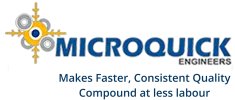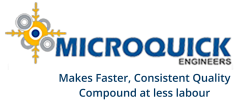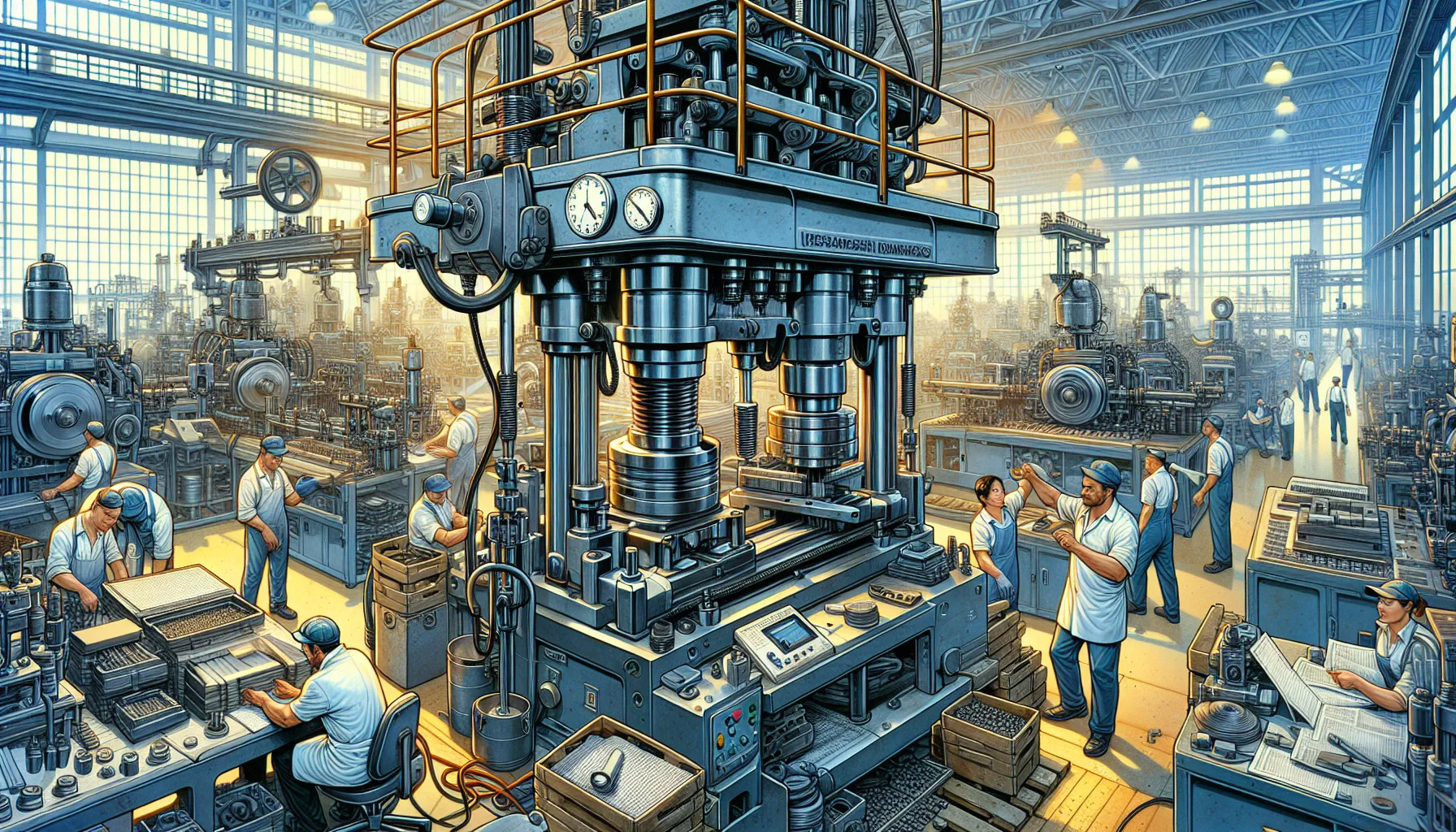Reducing costs in rubber products manufacturing is crucial for businesses aiming to stay competitive in the market. One effective way to achieve cost reduction is by utilizing hydraulic presses in the manufacturing process. Hydraulic presses play a vital role in the rubber products manufacturing industry, offering a range of benefits:
-
High Production Efficiency:
Hydraulic presses allow for faster cycle times and increased productivity, resulting in reduced labor costs. -
Low Energy Consumption:
These presses have low energy consumption, leading to overall cost savings. -
Versatility and Flexibility:
Hydraulic presses can handle a wide range of materials and product designs, reducing the need for specialized equipment and further contributing to cost savings.
Incorporating hydraulic presses in rubber products manufacturing can lead to substantial cost reduction. The efficiency, energy-saving capabilities, and versatility of these presses make them an excellent investment for businesses. By embracing this technology, companies can streamline their operations, improve productivity, and ultimately enhance their bottom line.
How Hydraulic Presses Achieve Cost Reduction in Rubber Products Manufacturing
Hydraulic presses offer various features and functionalities that contribute to cost reduction in rubber products manufacturing:
- High production efficiency with faster cycle times and increased productivity
- Low energy consumption leading to overall cost savings
- Versatility and flexibility in handling a wide range of materials and product designs
By utilizing hydraulic presses, businesses can achieve cost reduction and optimize their manufacturing processes.
Understanding Hydraulic Presses
Hydraulic presses are powerful machines that use hydraulic cylinders to generate a compressive force. They are widely used in various industries for tasks such as metal forming, stamping, forging, and even in the production of rubber products. In this section, we will delve into what hydraulic presses are, how they work, and the key components that make them so efficient and versatile.
Components of a Hydraulic Press
At its core, a hydraulic press consists of two main components: a hydraulic cylinder and a hydraulic pump. The hydraulic cylinder is responsible for creating the force, while the hydraulic pump supplies the necessary hydraulic fluid to generate the pressure. When the pump is activated, it pushes the hydraulic fluid into the cylinder, causing the piston inside the cylinder to move and exert force on the material being processed.
Advantages of Hydraulic Presses
-
Ability to exert immense force: With hydraulic systems, pressures can reach thousands of pounds per square inch, allowing for the efficient shaping and forming of materials. This makes hydraulic presses ideal for applications that require high force, such as metalworking and rubber molding.
-
Advanced control system: Modern hydraulic presses are equipped with advanced control systems that allow operators to precisely control the force, speed, and timing of the press. This level of control ensures accurate and consistent results, reducing errors and improving productivity.
-
Processing of materials with greater thickness and strength: Hydraulic presses can process materials with greater thickness and strength, making them suitable for a wide range of applications, from simple bending to deep drawing.
-
Longer lifespan: Hydraulic presses have a longer lifespan compared to mechanical presses. The hydraulic system operates smoothly, resulting in less wear and tear on the components. This reduces the need for frequent maintenance and replacement of parts, leading to cost savings in the long run.
Microquick Engineers
Microquick Engineers, a leading manufacturer of hydraulic dispersion kneaders & compression moulding machine , brings their expertise in hydraulic technology to the world of rubber products manufacturing. With over 25 years of experience, they understand the unique needs and challenges of the industry. Their hydraulic dispersion kneaders offer excellent compounding performance and consistent quality compounding, making them a reliable choice for manufacturers.
Rubber Products Manufacturing: Cost Reduction Opportunities with Hydraulic Presses
Rubber products manufacturing can involve significant costs, but there are several areas where cost-saving opportunities can be explored. By implementing hydraulic presses, manufacturers can achieve cost reduction in various aspects of the production process. Let’s take a closer look at some of these potential savings and how hydraulic presses contribute to them.
Faster Batch Preparation Times
One area where cost savings can be achieved
is in batch preparation times
. With traditional methods, batch preparation for rubber compounding can take a considerable amount of time. However, hydraulic presses, such as Microquick Engineers’ Hydraulic Dispersion Kneaders, offer excellent compounding performance with batch preparation times of just 7-12 minutes. This significant reduction in preparation time translates into increased efficiency and productivity, ultimately leading to cost savings.
Improved Ingredient Dispersion and Consistent Quality Compounding
In addition to faster batch preparation, hydraulic presses also contribute to cost reduction
through their excellent dispersion of ingredients
and consistent quality compounding
. This ensures that the rubber products have consistent properties, reducing the need for rework or rejection of batches. By avoiding these quality issues, manufacturers can minimize waste and save on material costs.
Low Energy Consumption
Hydraulic presses are also known
for their low energy consumption
, which is another area where cost savings can be achieved. Microquick Engineers’ Hydraulic Dispersion Kneaders, specifically mentioned in their website summary, are designed to be energy-efficient. By using less energy during the compounding process, manufacturers can significantly reduce their energy costs, leading to overall cost reduction in rubber products manufacturing.
Durability and Maintenance Cost Reduction
Furthermore, the durability of hydraulic presses also contributes to cost savings. Microquick Engineers’ kneaders are built with wear-resistant properties in the mixing chamber and rotors. This means that the equipment requires less frequent maintenance or replacement of parts, reducing downtime and saving on maintenance costs. Additionally,
the innovative shaft seals
with lubrication passage prevent ingredient leakage, further improving operational convenience and reducing material waste.
Cost Savings Example
To illustrate the cost savings achieved with hydraulic presses, let’s consider a specific example. Company XYZ, a rubber products manufacturer, implemented Microquick Engineers’ Hydraulic Dispersion Kneaders in their production process. By reducing batch preparation times, improving ingredient dispersion, and minimizing energy consumption, Company XYZ was able to achieve a 15% reduction in production costs. This significant cost savings allowed them to remain competitive in the market and invest in further business growth.
The Advantages of Hydraulic Presses in the Manufacturing Process
Hydraulic presses are a valuable tool for improving efficiency and productivity in the manufacturing process. They offer several advantages that contribute to streamlining operations and achieving optimal results.
High Force Exertion
One of the key benefits of hydraulic presses is their ability to exert high levels of force. This allows for quick and precise shaping and forming of materials.
Automation Features
Hydraulic presses are equipped with automation features such as PLC-HMI operational and direct VFD drive. These features enhance efficiency by enabling operators to program and control the press with ease. This reduces the need for manual adjustments and minimizes human error. The integration of automation also enables continuous operation and reduces downtime, ultimately increasing productivity.
Consistency and High-Quality Results
Consistency and high-quality results are crucial in the manufacturing industry. Hydraulic presses excel in delivering both. The controlled application of force ensures uniformity in the shaping and forming of materials, resulting in consistent end products. This consistency is particularly important in industries such as automotive, where precision and reliability are paramount.
Operator-Friendly Designs
Microquick Engineers’ hydraulic presses stand out for their operator-friendly designs. These designs prioritize ease of use and accessibility, allowing operators to navigate the press comfortably and perform tasks efficiently. By reducing the learning curve and minimizing the risk of accidents or injuries, Microquick Engineers’ operator-friendly designs help optimize productivity and create a safer working environment.
Sources:
Hydraulic Presses: Reducing Material Waste in Rubber Product Manufacturing
Hydraulic presses are a valuable tool in the rubber products manufacturing process. They offer numerous benefits, including improved ingredient dispersion and reduced material waste.
Improved Ingredient Dispersion
One of the key ways hydraulic presses contribute to the creation of high-quality rubber products is through improved ingredient dispersion. Ensuring that the ingredients are evenly distributed throughout the mixture is crucial for consistent performance and durability in the final product. Hydraulic presses excel in achieving this level of dispersion, thanks to their powerful and efficient mixing capabilities.
-
Thorough mixing:
By using a hydraulic press, manufacturers can ensure that all the ingredients are thoroughly mixed, resulting in a more homogenous mixture. -
Higher quality end product:
A homogenous mixture means less chance of clumping or uneven distribution of ingredients, resulting in a higher-quality end product. -
Better control over properties:
Improved dispersion allows for better control over the final properties of the rubber, such as its hardness or flexibility. This is particularly important in industries like automotive or healthcare, where precision and consistency are paramount.
Preventing Ingredient Leakage
In addition to improved ingredient dispersion, hydraulic presses also feature
innovative shaft seals
with lubrication passages that prevent ingredient leakage. This not only ensures the integrity of the mixture but also reduces material waste.
-
Eliminating contamination:
Leaking ingredients can lead to contamination or uneven distribution, resulting in wasted material and increased costs. The use of effective shaft seals eliminates this issue. -
Efficient and cost-effective process:
Preventing ingredient leakage allows for a more efficient and cost-effective manufacturing process.
Reduced Material Waste
Reduced material waste is not only beneficial for the environment but also for the manufacturer’s bottom line. By minimizing waste, companies can save on raw material costs and improve their overall profitability. Hydraulic presses play a significant role in achieving these cost savings.
-
Consistent and uniform mixing:
Hydraulic presses provide consistent and uniform mixing, resulting in less material being discarded due to uneven distribution or contamination. -
Higher yield:
Less material waste leads to fewer rejected products and a higher yield of usable rubber.
Wear Resistance and Efficiency
In addition to reducing material waste, hydraulic presses also offer wear resistance properties that reduce the need for frequent maintenance or replacement of components. This durability ensures that the press can operate at its optimal level for extended periods, minimizing downtime and maximizing productivity.
-
Cost savings:
The wear resistance properties of hydraulic presses save on maintenance costs and improve overall efficiency in the manufacturing process.
Overall, hydraulic presses are a valuable asset in the rubber products manufacturing industry. Their ability to improve ingredient dispersion, prevent leakage, and reduce material waste leads to significant cost savings for manufacturers. Additionally, their wear resistance properties minimize maintenance needs, further contributing to cost reduction. By investing in hydraulic presses, manufacturers can improve the quality of their products, enhance efficiency, and ultimately achieve a competitive edge in the market.
Enhancing Safety and Minimizing Risks in the Rubber Products Manufacturing Industry
Ensuring the safety of operators is of utmost importance in the rubber products manufacturing industry. One crucial aspect of achieving this is through the use of hydraulic presses, which are equipped with various safety features. These features help reduce accidents and ensure the well-being of operators.
Safety Interlocks
One key safety feature of hydraulic presses is the use of safety interlocks. These interlocks ensure that the press cannot be operated unless all safety guards and doors are properly closed and secured. This prevents operators from coming into contact with moving parts or hazardous areas during the operation of the press.
Emergency Stop Buttons
In addition to safety interlocks, hydraulic presses are also equipped with strategically placed emergency stop buttons. These buttons allow operators to quickly halt the operation in case of any unforeseen circumstances or emergencies.
Operator-Friendly Features
Microquick Engineers, a leading manufacturer of hydraulic dispersion kneaders , understands the importance of operator safety. Their kneaders are designed with operator-friendly features that prioritize safety. For example, the kneaders are equipped with safety sensors that detect any abnormal operating conditions, such as excessive temperature or pressure, and automatically shut down the machine to prevent accidents. Moreover, the kneaders are designed to minimize noise levels, reducing the risk of hearing damage for operators working in close proximity to the machine.
Impact on Cost Reduction
Improved safety not only protects operators but also has a positive impact on cost reduction. Accidents in the workplace can result in downtime, medical expenses, and potential lawsuits, all of which can significantly impact a company’s bottom line. By investing in hydraulic presses with advanced safety features, manufacturers can minimize the risk of accidents and the associated costs. Additionally, a safe working environment boosts employee morale and productivity, leading to higher efficiency and reduced waste.
In conclusion, hydraulic presses with advanced safety features, such as safety interlocks and emergency stop buttons, play a crucial role in minimizing risks and preventing accidents in the rubber products manufacturing industry. Microquick Engineers’ kneaders go a step further by incorporating operator-friendly designs and safety sensors, further enhancing safety in the workplace. By prioritizing safety, manufacturers can not only protect their workforce but also reduce costs and improve overall operational efficiency.
Microquick Engineers’ Hydraulic Dispersion Kneaders: Enhancing Efficiency and Cost Savings in Rubber Processing
Microquick Engineers’ Hydraulic Dispersion Kneaders are a cost-effective solution for reducing manufacturing costs in the rubber products industry . With over 25 years of experience, Microquick Engineers is a leading manufacturer of these kneaders, which provide excellent compounding performance and dispersion of ingredients.
- Low energy consumption: The kneaders have low energy consumption, contributing to cost reduction.
- Wear resistance: The kneaders are highly durable and minimize the need for maintenance or replacement of parts.
- Innovative shaft seals: The kneaders feature innovative shaft seals that prevent ingredient leakage, reducing material waste and improving operational convenience.
Not only do Microquick Engineers’ Hydraulic Dispersion Kneaders offer cost-saving benefits, but they also enhance efficiency and safety in rubber processing equipment. With operator-friendly designs and automation features such as PLC-HMI operational and direct VFD drive, these kneaders optimize the mixing process and achieve consistent, high-quality results.
By using Microquick Engineers’ Hydraulic Dispersion Kneaders, manufacturers can:
- Improve productivity
- Minimize risks
- Enhance efficiency in rubber processing
Learn more about Microquick Engineers and their Hydraulic Dispersion Kneaders by visiting their website at microquick.us . You can also explore their blog post titled “10 Tips for Optimizing Performance and Efficiency of Your Dispersion Mixer” for additional insights. For further information and resources, download their brochure mentioned on various pages, such as microquick.us/tag/calendering .
If you have any inquiries, contact Microquick Engineers through their contact information provided on various pages, such as microquick.us/tag/adjust .
Start reducing costs and improving your rubber products manufacturing process with Microquick Engineers’ expertise and reliable hydraulic press solutions.


